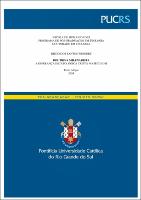| Share record |


|
Please use this identifier to cite or link to this item:
https://tede2.pucrs.br/tede2/handle/tede/11232Full metadata record
| DC Field | Value | Language |
|---|---|---|
| dc.creator | Wingert, Diego dos Santos | - |
| dc.creator.Lattes | http://lattes.cnpq.br/6655859644622507 | por |
| dc.contributor.advisor1 | Fernandes, Rafael Martins | - |
| dc.contributor.advisor1Lattes | lattes.cnpq.br/2560189833702112 | por |
| dc.date.accessioned | 2024-05-28T13:07:47Z | - |
| dc.date.issued | 2024-03-26 | - |
| dc.identifier.uri | https://tede2.pucrs.br/tede2/handle/tede/11232 | - |
| dc.description.resumo | A respectiva tese apresenta uma ampla pesquisa bibliográfica, que indica, organiza e vincula o desenvolvimento escatológico-milenarista a partir de uma investigação histórica, bíblica e sistemática, desde a sua primitiva matriz judaica, até o seu setorial estágio final junto ao cristianismo do Século II, procurando a partir disso, estabelecer como tese a existência da crença milenar cristã como uma doutrina catequética, exercida de forma universal, até o final do período identificado. A pesquisa acaba por também redefinir alguns aspectos congruentes ao tema central, que foram estabelecidos historicamente de maneira equivocada por meio da pesquisa sistemática. Entre estes está a mudança substancial entre o milenarismo judaico e o cristão. A partir desta temática, um amplo contexto passa a ser descrito por meio de uma metodologia híbrida, que de maneira inicial, apresenta o desenvolvimento histórico a respeito do fenômeno milenar desde o movimento judaico do Século VII a.C., até a doutrina cristã do período sinalizado; posteriormente, passa a dissertar e comentar sobre a magma relação escriturística e literária que endossam as previsões escatológicas sobre o Millennium; segue examinando a potencial área que viabiliza sua relação de caso: a sistematização dos Pais (Justino, Ireneu e Tertuliano), que de forma argumentativa, são elevados a uma perspectiva dogmática; por fim, numa ação interdisciplinar, o conceito de universalidade da doutrina milenar ganha forma, projeção e viabilidade a partir da sua localização e abrangência no tempo e no meio social que se estabilizou. Deste modo, se desenvolveu o conceito de universalidade da doutrina milenar junto a praxe cristã, considerada proto-ortodoxa, no contexto final do Século II. | por |
| dc.description.abstract | The respective thesis presents a broad bibliographical research, which indicates, organizes and links the eschatological-millennialist development based on a historical, biblical and systematic investigation, from its primitive Jewish matrix, to its final sectoral stage with Christianity in the 2nd Century. , seeking from this, to establish as a thesis the existence of ancient Christian belief as a catechetical doctrine, exercised universally, until the end of the identified period. The research also ends up redefining some aspects congruent with the central theme, which were historically incorrectly established through systematic research. Among these is the substantial shift between Jewish and Christian millennialism. From this theme, a broad context begins to be described through a hybrid methodology, which initially presents the historical development regarding the ancient phenomenon from the Jewish movement of the 7th Century BC, to the Christian doctrine of the period highlighted; subsequently, he begins to discuss and comment on the great scriptural and literary relationship that endorse the eschatological predictions about the Millennium; continues examining the potential area that makes their case relationship viable: the systematization of the Parents (Justino, Irenaeus and Tertuliano), who, in an argumentative way, are elevated to a dogmatic perspective; Finally, in an interdisciplinary action, the concept of universality of the ancient doctrine gains shape, projection and viability based on its location and scope in time and in the social environment that has stabilized. In this way, the concept of universality of the ancient doctrine developed alongside Christian practice, considered proto-orthodox, in the final context of the 2nd Century | eng |
| dc.description.provenance | Submitted by PPG Teologia ([email protected]) on 2024-05-06T19:04:27Z No. of bitstreams: 1 DIEGO_DOS_SANTOS_WINGERT_TES.pdf: 2522806 bytes, checksum: ed90ace3a869382f1f1923dad04ae6dc (MD5) | eng |
| dc.description.provenance | Approved for entry into archive by Sarajane Pan ([email protected]) on 2024-05-28T13:01:21Z (GMT) No. of bitstreams: 1 DIEGO_DOS_SANTOS_WINGERT_TES.pdf: 2522806 bytes, checksum: ed90ace3a869382f1f1923dad04ae6dc (MD5) | eng |
| dc.description.provenance | Made available in DSpace on 2024-05-28T13:07:47Z (GMT). No. of bitstreams: 1 DIEGO_DOS_SANTOS_WINGERT_TES.pdf: 2522806 bytes, checksum: ed90ace3a869382f1f1923dad04ae6dc (MD5) Previous issue date: 2024-03-26 | eng |
| dc.description.sponsorship | Coordenação de Aperfeiçoamento de Pessoal de Nível Superior - CAPES | por |
| dc.format | application/pdf | * |
| dc.thumbnail.url | https://tede2.pucrs.br/tede2/retrieve/190644/DIEGO_DOS_SANTOS_WINGERT_TES.pdf.jpg | * |
| dc.language | por | por |
| dc.publisher | Pontifícia Universidade Católica do Rio Grande do Sul | por |
| dc.publisher.department | Escola de Humanidades | por |
| dc.publisher.country | Brasil | por |
| dc.publisher.initials | PUCRS | por |
| dc.publisher.program | Programa de Pós-Graduação em Teologia | por |
| dc.rights | Acesso Aberto | por |
| dc.subject | Milênio | por |
| dc.subject | Patrística | por |
| dc.subject | Escatologia | por |
| dc.subject | Século II d.C. | por |
| dc.subject | Millennium | eng |
| dc.subject | Patristics | eng |
| dc.subject | Eschatology | eng |
| dc.subject | 2nd Century AD. | eng |
| dc.subject.cnpq | CIENCIAS HUMANAS::TEOLOGIA | por |
| dc.title | Doutrina milenarista a esperança escatológica cristã no século II | por |
| dc.type | Tese | por |
| dc.restricao.situacao | Trabalho não apresenta restrição para publicação | por |
| Appears in Collections: | Programa de Pós-Graduação em Teologia | |
Files in This Item:
| File | Description | Size | Format | |
|---|---|---|---|---|
| DIEGO_DOS_SANTOS_WINGERT_TES.pdf | DIEGO_DOS_SANTOS_WINGERT_TES | 2.46 MB | Adobe PDF |  Download/Open Preview |
Items in DSpace are protected by copyright, with all rights reserved, unless otherwise indicated.




